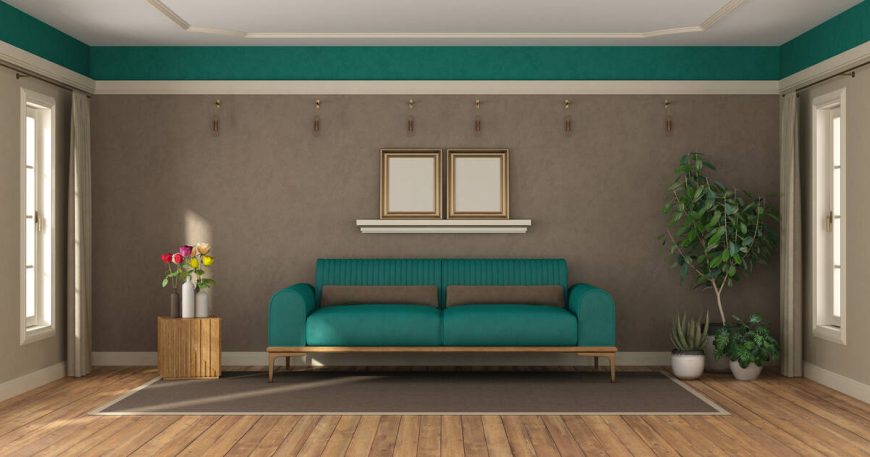
The use of color in interior design is one of the strongest tools. It can change spaces, stimulate emotions, and represent personality. The appropriate color choice would make a small room look large, a small corner welcoming or the whole house blend harmoniously and vibrantly. When one wants to redecorate his or her space, the idea of applying and knowing about the Eye-Catching Color Schemes is a major key to the realization of the beautiful, as well as functional, interiors.
We will discuss the ability to pick and mix colors in the best way, the psychological effects of various colors, and useful facts to design your home to be energized, relaxed, or warm, whatever you want it to be.
Understanding Color Theory
Color theory is the basis of a successful design. This is the analysis of color interacting with each other, complementing, or contrasting with each other. Such a fundamental understanding of the color wheel can assist housewives to make a wise choice. One does not need a lot of colors, contrasts of complementary colors make bold, which is stimulating an area like blue and orange. Similar colors such as blue, teal, and green provide usual harmony and transition.
Effective Eye-Catching Color Schemes do not only look good but also harmoniously. Excessive conflicting colours may be chaotic whereas too dull colours may not be interesting. It is important to know undertones, temperature (warm or cool) and saturation to have cohesive interiors.
Choosing a Base Color
All rooms have a base color which defines the mood of the room. Soft grays, beige or white neutral colors are flexible and give the color nearby an opportunity to shine. Deep navy or emerald green is a bold base color and it is dramatic and focus-creating.
The choice of a base should be based on the purpose of a room. Home offices or studios can be enhanced with livelier colors as compared to living rooms which usually possess warm and inviting neutral tones. The next tip of one of the most important Eye-Catching Color Schemes is to make sure your base color fits in with furniture, flooring and lighting.
Accent Colors: Adding Personality and Energy
Accent colors make the interior interesting and deep and give it life. These are the colours that you use in smaller quantities on pillows, curtains, carpets or wall decorations. As an example, a minimalistic living room can be reinvigorated with mustard yellow details, or a minimalistic gray bedroom can be made warm with blush pink details.
Effective Eye-Catching Color Schemes apply accents to emphasize architectural elements, direct attention or create an atmosphere. The accent color is one of the most effective and reasonable means of interior improvement as it can completely change a space with a well-chosen accent color, and a full paint is not always needed.
The Psychology of Color in Interiors
Colors influence emotions and action. The warm colors such as red, orange and yellow are energizing and encourage people to talk hence they are best suited in the kitchen or the living room. Blue, green and lavender tones are cool colors that are relaxing and concentrated and are ideal to use in bedrooms and work places.
The neutral shades are grounding and open to more expressive ones. In the formation of the Eye-Catching Color Schemes, the psychological implication should be taken into account. It is aimed at the creation of purposeful spaces which help in both practicality and atmosphere.
Mixing Textures and Patterns with Color
Colors do not exist alone, but they combine with texture and pattern. The palette can be deepened by the use of such materials as velvet, wood, or metal, which are monochromatic. On the other hand, designs like stripes, florals or geometrical designs provide a visual movement to the monotony.
The use of different types of textures is a guarantee that even minor Eye-Catching Color Schemes will appear dynamic and interesting. A minimalist space may be converted into a visually rich space by oversharing a soft cream rug, a woven blanket, and metallic details of the decor.
Lighting and Its Role in Color Perception
Lighting may dramatically change the appearance of colors. The natural light brings out the actual colors of a paint color whereas artificial lighting may produce the same color to be warmer or cooler. The use of layered lighting (ambient, task and accent) is also crucial to your color selection, as it will appear as desired in every part of the room.
The testing of paint swatches in various lighting conditions is one of the most important strategies of the Eye-Catching Color Schemes. This is the easiest trick to avoid unexpected events and ensure the colors you pick can help to achieve the needed effect.
Trends and Timeless Principles
Although it is thrilling to abide by the interior design trends, perennial principles guarantee sustainability. Feminine colors such as dark hues, light pastels and rich jewel tones are all on trend at present, whereas, soft whites, slate gray, and beige are classic and here to stay.
Mixing fashionable accents and classic foundation colors leads to Eye-Catching Color Schemes that are not only modern but do not become outdated too fast. The style is a medium where the creativity, aesthetic, and feasible durability are balanced in home design.
Personalization and Cohesion
The color scheme must be representative of your personality. Be it lively and entertaining, simple and relaxing, or luxurious and classy, coordinated color themes would have your home united. Co-ordination of the colours of your walls, furniture, textiles and decals of your rooms to provide a smooth flow between the rooms.
A proper plan of Eye-Catching Color Schemes makes all spaces interrelate with each other without losing their purpose as well as its energy. Cohesion does not imply being singly, it is more of harmony, rhythm and deliberate contrast.
Frequently Asked Questions (FAQs)
1: How do I choose the best color palette for my home?
Start with a base color that complements your furniture and flooring. Then select two to three accent colors to create interest and contrast. Consider mood, lighting, and room function.
2: Can I combine multiple bold colors without overwhelming the space?
Yes, but it’s best to use bold colors sparingly as accents or in one dominant area, balancing them with neutral tones to maintain harmony.
3: How do lighting choices affect my color scheme?
Natural and artificial light can make the same color appear different. Test swatches under both daylight and indoor lighting before committing to large-scale applications.
Final Thoughts
The appropriate choice of colors will turn a house into a miracle. Considerable use of Eye-Catching Color Schemes produces spaces that are not only attractive to the eye, but very appealing to the heart. Knowing color theory, experimenting with textures, thinking about lighting, and juxtaposing trends with eternal values will help homeowners create an interior that would be reflective of both style and personality.
Every space has potential. The rooms may be warm, energetic, relaxing, or classy with the right choice of color, saturation, and positioning. So experiment, trust and see your interiors come to life with color and attractiveness.


